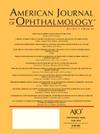Rate of Progression Among Different Age Groups in Glaucoma With High Myopia: A 10-Year Follow-Up Cohort Study
IF 4.1
1区 医学
Q1 OPHTHALMOLOGY
引用次数: 0
Abstract
PURPOSE
To investigate the rate of structural and functional progression in different age groups of highly myopic glaucoma patients and identify risk factors associated with rate of change in functional parameters.
DESIGN
Retrospective clinical cohort study.
METHODS
This study included open-angle, normal-tension glaucoma (NTG) patients with high myopia who had been followed-up for at least 8 years. Patients were divided into two age groups, “younger (under age 40)” and “older (age 40 or over),” according to their age at presentation, and progression rates for visual field index (VFI), mean deviation (MD) and peripapillary retinal nerve fiber layer (RNFL) thickness were evaluated. Intergroup comparison was performed, and associations between age and progression rates for structural and functional parameters were assessed by scatter plots with linear regression and locally weighted scatterplot smoothing. Cox proportional hazards modeling was performed to identify factors for progression rate of functional parameters.
RESULTS
A total of 320 eyes of 320 highly myopic NTG patients (mean age at presentation, 38.7 ± 10.4 years) were included in this study with a mean follow-up duration of 13.1 ± 6.2 years. The rate of VFI, MD, and RNFL thickness change showed a positive correlation with the age at presentation (P = .013, .002, and .003, respectively). The mean rate of MD change was −0.36 ± 0.39 dB/year in younger age group and −0.22 ± 0.27 dB/year in older age group (P < .01). In the locally weighted scatterplot, the rate of change in VFI, MD, and RNFL thickness showed a fast-progressing pattern in those aged 19 to 29 years and 40 to 49 years, and a slow-progressing pattern in those aged 30 to 39 years and 50 years or older. Baseline IOP (β= −0.041; 95% CIs, −0.139-0.413; P = .047) and baseline VFI (β= 0.364; 95% CIs, 0.247-0.461; P < .01) was significantly related to the VF MD change rate.
CONCLUSIONS
The glaucoma progression rate in highly myopic NTG showed a bimodal pattern based on the age at presentation, younger patients exhibiting faster progression compared to older patients. Baseline IOP and VFI were significantly related to functional progression rate. The findings of this study may assist in deciding the treatment strategy for highly myopic NTG patients.
不同年龄组青光眼伴高度近视的进展率:一项10年随访队列研究。
目的探讨不同年龄组高度近视青光眼患者的结构和功能进展速度,并确定与功能参数变化率相关的危险因素。方法:本研究纳入高度近视的开角、正常张力青光眼(NTG)患者,随访至少8年。根据患者的发病年龄,将患者分为“年轻(40岁以下)”和“年长(40岁或以上)”两个年龄组,并评估视野指数(VFI)、平均偏差(MD)和乳头周围视网膜神经纤维层(RNFL)厚度的进展率。进行组间比较,并通过线性回归和局部加权散点图平滑的散点图评估年龄和结构和功能参数进展率之间的关系。采用Cox比例风险模型确定影响功能参数进展率的因素。结果本研究共纳入320例高度近视NTG患者320只眼,平均发病年龄38.7±10.4岁,平均随访13.1±6.2年。VFI、MD、RNFL厚度变化率与发病年龄呈正相关(p=0.013、0.002、0.003)。低龄组平均MD变化率为-0.36±0.39 dB/年,高龄组平均MD变化率为-0.22±0.27 dB/年(p<0.01)。在局部加权散点图中,VFI、MD和RNFL厚度的变化率在19-29岁和40-49岁表现为快速发展模式,而在30-39岁和50岁及以上表现为缓慢发展模式。基线IOP (β= -0.041;95% ci, -0.139-0.413;p=0.047)和基线VFI (β= 0.364;95% ci为0.247 ~ 0.461;p<0.01)与VF MD变化率显著相关。结论高度近视NTG患者青光眼的进展率与发病年龄呈双峰型关系,年轻患者比老年患者进展更快。基线IOP和VFI与功能进展率显著相关。本研究结果可能有助于决定高度近视NTG患者的治疗策略。
本文章由计算机程序翻译,如有差异,请以英文原文为准。
求助全文
约1分钟内获得全文
求助全文
来源期刊
CiteScore
9.20
自引率
7.10%
发文量
406
审稿时长
36 days
期刊介绍:
The American Journal of Ophthalmology is a peer-reviewed, scientific publication that welcomes the submission of original, previously unpublished manuscripts directed to ophthalmologists and visual science specialists describing clinical investigations, clinical observations, and clinically relevant laboratory investigations. Published monthly since 1884, the full text of the American Journal of Ophthalmology and supplementary material are also presented online at www.AJO.com and on ScienceDirect.
The American Journal of Ophthalmology publishes Full-Length Articles, Perspectives, Editorials, Correspondences, Books Reports and Announcements. Brief Reports and Case Reports are no longer published. We recommend submitting Brief Reports and Case Reports to our companion publication, the American Journal of Ophthalmology Case Reports.
Manuscripts are accepted with the understanding that they have not been and will not be published elsewhere substantially in any format, and that there are no ethical problems with the content or data collection. Authors may be requested to produce the data upon which the manuscript is based and to answer expeditiously any questions about the manuscript or its authors.

 求助内容:
求助内容: 应助结果提醒方式:
应助结果提醒方式:


